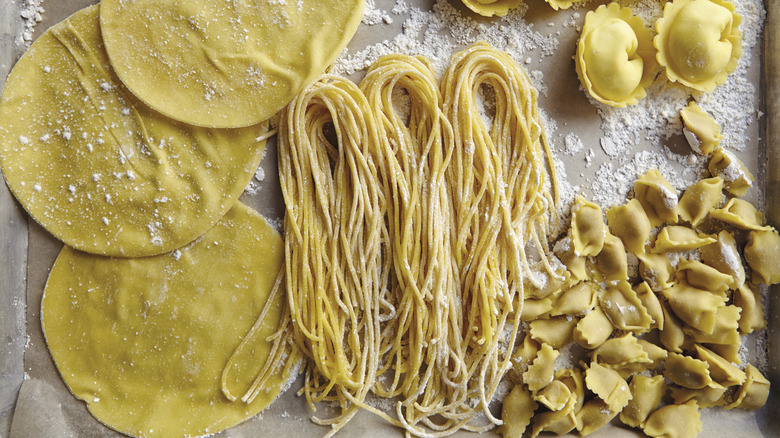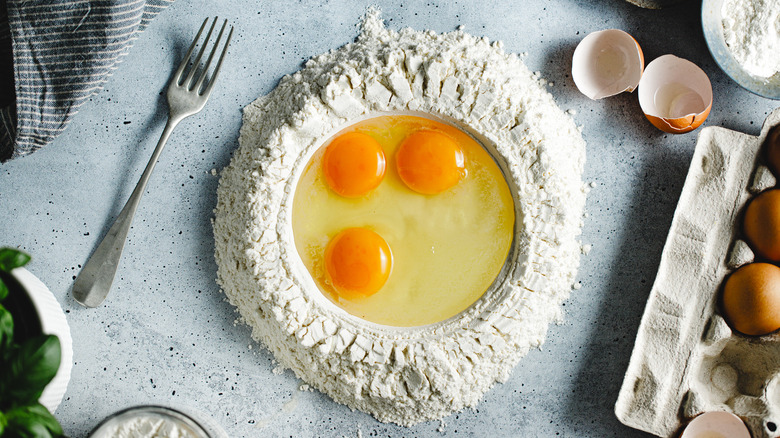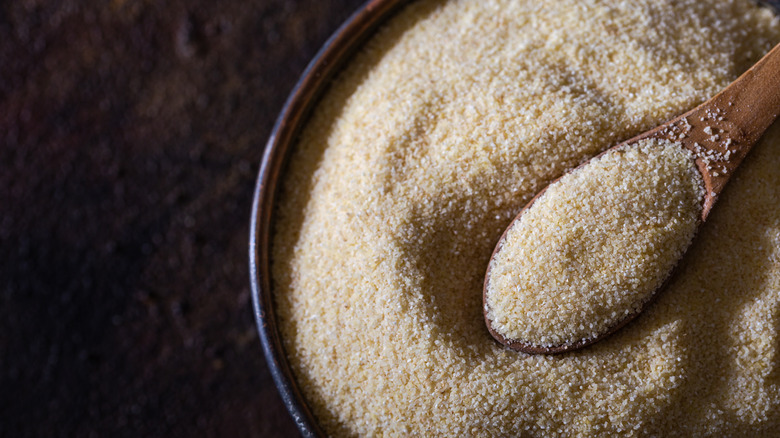The Best Flour For Egg Vs Egg-Free Pasta Dough
For many food lovers, making your own pasta is high up on the cooking bucket list, right next to making your own bread. Whether you're making noodles to dry and save for some weeknight pasta recipes, or you're looking to make the best pasta shape for your sauce, having this skill in your kitchen arsenal will make friends and family line up for your epic dinner parties. But since pasta only requires a few ingredients — like flour, eggs, and salt — using the right ones is vital to the final product. So which flour is actually the best when it comes to making fresh pasta? Well, that depends on the kind you're making.
When deciding which type of pasta to make, know that pasta containing eggs is gorgeously tender, and lends itself well to stuffed pastas like ravioli because it's easy to roll out and shape. Its eggless counterpart, on the other hand, is sturdier and is perfect for dishes that include heavy, hearty sauces, like a rich ragù, or baked dishes like lasagna.
If you're making egg pasta, using white flour is best because it contains less protein, helping it to achieve a luxuriously soft texture. Eggless pasta, which should be more firm and chewy, is best made with semolina flour, thanks to its higher protein content that creates a sturdier dough.
The best flour for egg pasta
Using a soft wheat white flour, like Italian 00 flour (also called doppio zero), is ideal when making egg pasta. In Italy and other parts of Europe, flour is categorized by how finely it's ground, with a level system of 00, 0, 1, and 2 (with 00 being the finest and 2 being the coarsest).
Because 00 flour has a powdery texture and a high gluten content, it works wonderfully for tender and smooth pasta. This is because the high gluten allows for more water absorption, giving the dough more elasticity, and the fine texture ensures that the dough won't turn out rubbery and easy to tear. This combination creates a more flexible and delicate pasta foundation that can be rolled out thinly without cracking. While Italian 00 flour is superior for egg pasta, you can use all-purpose flour in a pinch and still get a beautiful result.
After you mix, knead, and roll it, egg pasta dough has to be dried out a bit before cutting (so that it isn't too sticky). Sprinkle a baking sheet with flour and lay the sheets on top, letting them dry for 15 minutes. Then, cut them into your desired shape and dry for an additional 15 minutes before cooking. Note that fresh egg pasta cooks up quickly, only taking one to five minutes in boiling water. The pasta is best used immediately, but can be stored in the refrigerator for up to three days.
The best flour for egg-free pasta
When making egg-free pasta, you'll want to use hard wheat flour, thanks to its higher protein content that makes sure the dough doesn't fall apart. That's where semolina flour, a durum wheat type that's golden in color, comes in. Semolina comes in three levels of grinds, with the coarsest grind being ideal for sprinkling on fresh pasta to ensure it doesn't stick and the medium grind being perfect for making eggless pasta dough.
According to WebMD, semolina flour boasts around 21 grams of protein per 1-cup serving. That's around 13% protein content, whereas regular all-purpose flour comes in around 8% to 11%, depending on the brand (via Bob's Red Mill). This means that semolina doesn't need the binding that an egg provides, due to its naturally sturdier nature. It's also commonly used to make commercial dried pasta because noodles made with it store well.
When making eggless pasta dough, you'll only need semolina flour, salt, and water (egg pasta just adds eggs and oil to the mix). Due to being firmer, eggless dough takes a bit more elbow grease to knead. Despite these differences, you can dry it before cooking exactly as you would for egg pasta. It also cooks up quickly in boiling water, in about three to five minutes. If you want to store it for later use, this pasta can be kept in a cool, dry place for about three months after it's been fully dried.



